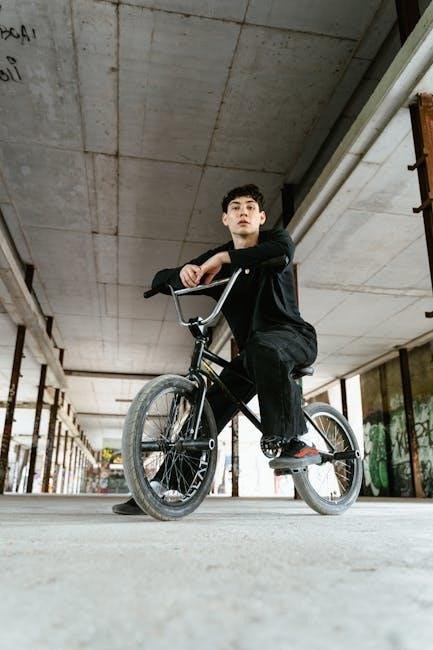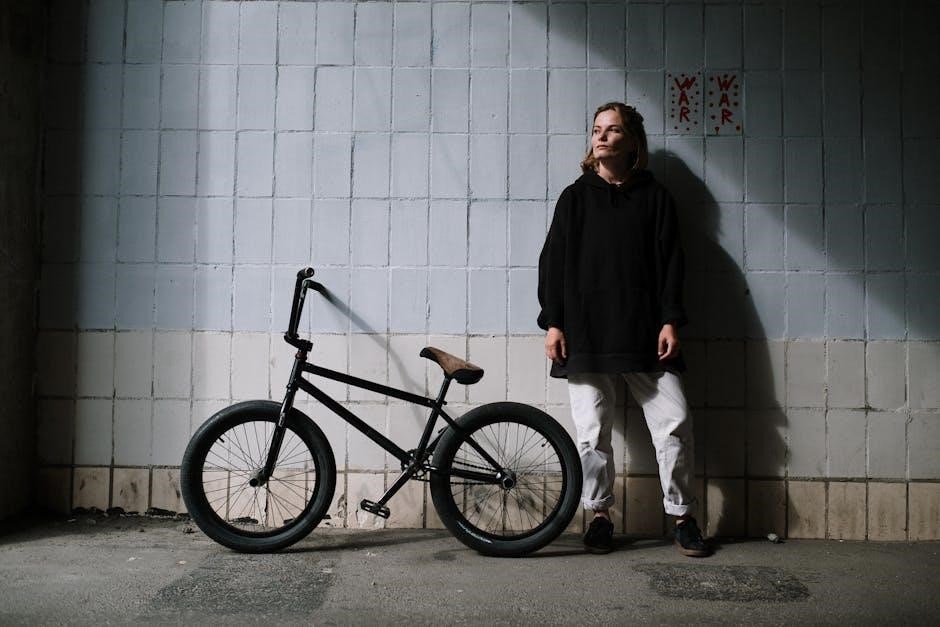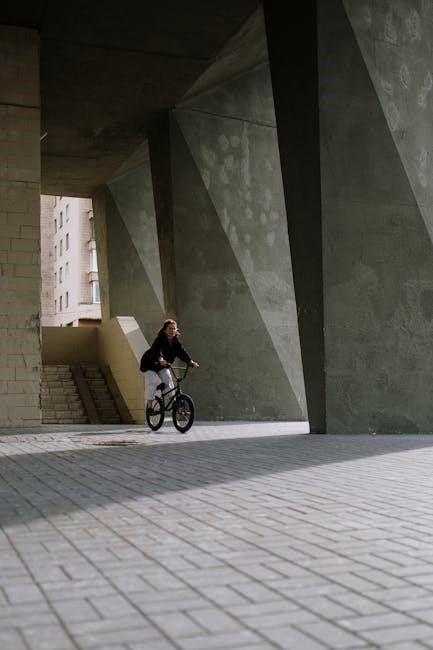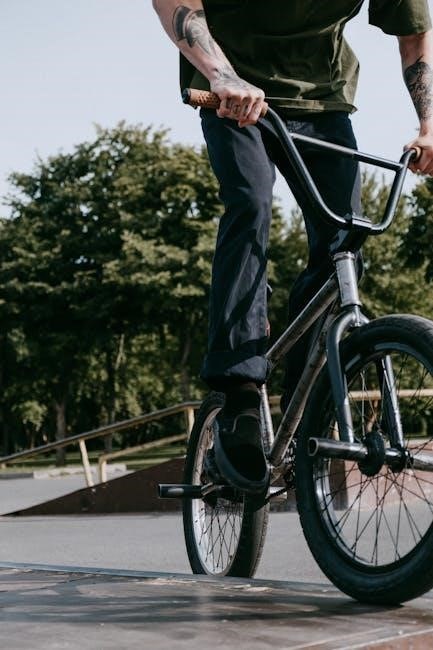BMX bikes are sized based on wheel diameter and frame length, with 20-inch wheels being standard. Proper fit ensures optimal performance, comfort, and control for riders of all levels.

Factors Determining BMX Frame Size
The size of a BMX bike frame is determined by several factors, including rider height, wheel size, and sometimes riding style. These factors help ensure the bike feels right and functions well for the rider.
2.1 Rider Height
Rider height is a key factor in determining the appropriate BMX frame size. Taller riders typically require longer frames for comfort and efficiency, while shorter riders benefit from more compact frames. Generally, frame size is matched to the rider’s height to ensure proper leg clearance and optimal reach to the handlebars. For example, a rider standing between 5’4″ and 5’8″ might prefer a 20.5″ to 21″ top tube length, while taller riders might opt for larger frames. Proper sizing ensures better control, maneuverability, and overall riding performance. Always consider height as a starting point when selecting a BMX bike frame;
2.2 Wheel Size
Wheel size is a critical factor in BMX bike frame sizing, with 20-inch wheels being the standard for most BMX bikes. However, variations exist, such as 16-inch wheels for younger riders or 22-24-inch wheels for cruisers. The wheel size directly impacts the bike’s handling, stability, and maneuverability. Larger wheels provide more stability at higher speeds, while smaller wheels offer better agility for tricks and tight spaces. Riders should choose a wheel size that aligns with their riding style and preferences. Proper wheel size ensures the bike feels balanced and responsive, contributing to an optimal riding experience; Always consider wheel size when selecting a frame.
Types of BMX Bikes
BMX bikes are categorized into Racing, Freestyle, and Cruiser types, each designed for specific riding styles and purposes, ensuring optimal performance and comfort.
3.1 Racing BMX
Racing BMX bikes are designed for speed and agility on closed circuits, typically featuring lightweight frames, aerodynamic designs, and 20-inch wheels. They emphasize minimal weight and maximum responsiveness, making them ideal for competitive racing. Frame sizes vary to suit rider height, ensuring optimal power transfer and control. Top tube lengths range from 20 to 22 inches, catering to different rider proportions. The geometry is optimized for sprinting and tight turns, with a focus on stability at high speeds. Proper fit is crucial for performance, as it directly impacts pedaling efficiency and handling during races.
3.2 Freestyle BMX
Freestyle BMX bikes are built for tricks, stunts, and versatility, often featuring durable frames and 20-inch wheels. They prioritize strength and maneuverability, making them ideal for skate parks, streets, or dirt trails. Frame sizes vary to accommodate rider preferences, with shorter top tubes for better control during tricks. Freestyle bikes often have a more compact geometry compared to racing models, allowing for easier handling in tight spaces. Riders choosing a freestyle BMX should consider their riding style—whether focused on technical tricks or aggressive moves—and ensure the frame size aligns with their height and performance needs for optimal comfort and responsiveness.
3.3 Cruiser BMX
Cruiser BMX bikes are designed for casual riding, offering comfort and stability on various terrains. They typically feature larger wheel sizes, ranging from 24 inches and up, and longer frames compared to standard BMX bikes. Cruiser BMX bikes are ideal for relaxed rides, beach cruises, or dirt paths. Their frame sizes are often tailored to accommodate taller riders, ensuring a comfortable riding position. The emphasis is on versatility and ease of use, making them a great choice for those prioritizing enjoyment over high-performance tricks or racing. Riders seeking a laid-back, stress-free experience often prefer cruiser BMX bikes for their durability and smooth handling.

Understanding BMX Frame Geometry
BMX frame geometry is crucial for performance, influencing handling and stability. Key components include top tube length, seat tube angle, head tube angle, and wheelbase, each affecting ride dynamics.
4.1 Top Tube Length
The top tube length is a critical measurement in BMX frame geometry, directly influencing handling and stability. It is the distance between the head tube and the seat tube, measured horizontally. A longer top tube provides more stability at high speeds but can make the bike less maneuverable in tight spaces. For freestyle riding, shorter top tubes are preferred for better agility and easier trick execution. Riders should consider their height, riding style, and preferred discipline when selecting a frame, as top tube length affects both comfort and performance. Proper fit ensures optimal control and responsiveness, making it a key factor in frame selection.
4.2 Seat Tube Length
The seat tube length is a fundamental measurement in BMX frame geometry, determining the bike’s standover height and riding position. It is measured from the bottom bracket to the top of the seat tube. A longer seat tube provides more room for taller riders, while shorter tubes suit smaller riders. Proper seat tube length ensures adequate standover clearance, which is essential for control and safety, especially during jumps and tricks. Riders should match their height to the frame’s seat tube length for optimal fit. This measurement is often standardized but can vary slightly between manufacturers, making it crucial to consult a size chart or test ride a bike before purchase.
4.3 Head Tube Angle
The head tube angle plays a significant role in a BMX bike’s handling and responsiveness. It is measured in degrees and determines how the bike turns and maneuvers. A steeper head tube angle (closer to 90 degrees) provides quicker, more precise steering, ideal for freestyle tricks and tight corners. A slacker angle (closer to 74 degrees) offers greater stability at higher speeds, often preferred for racing. The angle impacts the bike’s overall geometry, affecting how the rider interacts with the terrain. Proper alignment ensures optimal performance, making it essential to consider riding style and terrain when selecting a frame with the appropriate head tube angle.
4.4 Wheelbase
The wheelbase of a BMX bike is the distance between the front and rear axles, significantly influencing handling and stability. It is determined by the top tube length, seat tube length, and wheel positions. A longer wheelbase enhances stability at high speeds, making it ideal for racing, while a shorter wheelbase improves maneuverability, suiting freestyle riding. The wheelbase affects how the bike responds to turns and accelerations, with longer bases providing a more predictable ride and shorter ones offering quicker reactions. Riders should consider their riding style and terrain when choosing a frame, as the wheelbase directly impacts the bike’s overall performance and responsiveness.
How to Choose the Right Frame Size
Choosing the right BMX frame size involves measuring rider height, using a BMX frame size chart, and ensuring proper standover height for comfort and control.
5.1 Measuring the Rider
To determine the right BMX frame size, start by measuring the rider’s height without shoes. Use a height chart or tape measure to get an accurate reading. Standover height is critical; there should be 1-2 inches of clearance between the rider’s inseam and the frame for optimal comfort and control. This ensures proper fit and avoids discomfort or difficulty in handling the bike. Measure the rider’s inseam by having them stand straight with feet shoulder-width apart and a book or ruler pressed against the groin area. This step is essential for matching the rider’s dimensions to the appropriate frame size using a BMX frame size chart.
5.2 Using a BMX Frame Size Chart
A BMX frame size chart is a valuable tool to match rider dimensions with the appropriate frame size. These charts typically list frame sizes in inches, corresponding to rider height and inseam measurements. They provide a general guide, but sizes may vary slightly between manufacturers due to differences in frame geometry. To use a chart effectively, locate the rider’s height range and cross-reference it with the recommended frame size. Keep in mind that riding style and personal preference can influence the final choice. While charts are helpful, test-riding a bike is always recommended to ensure the best fit and optimal performance.
5.3 Standover Height
Standover height is a critical measurement for determining bike fit. It is the distance from the ground to the top of the frame, measured vertically. This measurement helps ensure the bike is the right size for the rider, providing adequate clearance for comfort and safety. A proper standover height allows the rider to straddle the bike with a slight bend in the knees, typically around 1-2 inches of clearance for BMX bikes. This ensures optimal efficiency, control, and maneuverability while riding. Standover height is a key factor in selecting the correct frame size, complementing other measurements like rider height and inseam length for the best fit.
How Frame Size Affects Ride Quality
Frame size significantly impacts ride quality, affecting handling, stability, and comfort. Proper sizing ensures optimal performance and control for riders of all levels and riding styles.
6.1 Handling and Responsiveness
Frame size directly influences a BMX bike’s handling and responsiveness. A smaller frame provides quicker reflexes and tighter turning capabilities, ideal for freestyle tricks and tight maneuvers. Conversely, a larger frame may feel more sluggish but offers stability at higher speeds. The top tube length and wheelbase play crucial roles in determining how responsive the bike feels. Riders preferring agility and precision in technical settings benefit from shorter frames, while those prioritizing speed and stability may opt for slightly longer frames. Balancing these factors ensures the bike feels intuitive and predictable, enhancing overall ride quality and performance for the rider’s specific needs and style.
6.2 Stability and Speed
Frame size significantly impacts a BMX bike’s stability and speed. Larger frames tend to offer greater stability at higher speeds, making them ideal for racing and cruiser BMX bikes. A longer wheelbase enhances stability by spreading the bike’s weight more evenly, reducing wobble and improving control during fast rides. Conversely, smaller frames may sacrifice some stability for agility and quicker acceleration. The balance between frame size and wheelbase ensures optimal performance, allowing riders to maintain speed without compromising maneuverability. Proper frame sizing is crucial for achieving the desired stability and speed, ensuring a smooth and efficient ride across various terrains and riding styles.
6.3 Rider Comfort
Rider comfort is directly influenced by the frame size of a BMX bike. A correctly sized frame ensures the rider isn’t overly stretched or cramped, reducing fatigue and discomfort during rides. Proper standover height and seat tube length allow for a natural riding position, with knees slightly bent for optimal pedaling efficiency. A frame that is too small or too large can lead to strain on the back, neck, and legs, especially on longer rides or during intense sessions. Ensuring the right fit is crucial for maintaining comfort, control, and enjoyment, whether riding freestyle, racing, or cruising casually.

Common Mistakes to Avoid
Common mistakes include ignoring rider height, not considering riding style, and skipping test rides. These oversights can lead to poor fit and reduced performance.
7.1 Ignoring Rider Height
Ignoring rider height is a common mistake when selecting a BMX bike. Proper frame size ensures optimal performance, comfort, and safety. A bike that’s too small or large can lead to poor handling, reduced stability, and increased risk of injury. Riders should consult size charts to match their height with the appropriate frame length and wheel size. For example, shorter riders benefit from smaller frames, while taller riders need longer frames for better control. Neglecting this step often results in a bike that doesn’t fit well, making it harder to maneuver and less enjoyable to ride. Always prioritize height when choosing a BMX bike.
7.2 Not Considering Riding Style
Not considering riding style is another common mistake when choosing a BMX bike. Different styles, such as racing, freestyle, or cruising, require specific frame sizes and geometries. For example, racers prioritize speed and responsiveness, needing a shorter, stiffer frame, while freestyle riders require durability and maneuverability, often opting for a slightly longer frame. Cruisers focus on comfort and stability, benefiting from a relaxed geometry. Ignoring riding style leads to a bike that doesn’t meet the rider’s needs, affecting performance and safety. Always match the bike’s design to the intended use for optimal results and a more enjoyable riding experience.
7.3 Not Test-Riding
Not test-riding a BMX bike is a significant oversight. While size charts provide a starting point, they can’t replicate the feel of a bike. Factors like standover height, reach, and handling vary between models. Riders may discover that a frame deemed suitable by charts feels too cramped or unwieldy in real life. Test-riding allows for adjustments in stem height, handlebars, and saddle position, ensuring a tailored fit. Skipping this step can lead to discomfort, poor performance, or even safety issues. Always visit a bike shop to test ride potential bikes, ensuring the chosen frame aligns with your riding style and comfort needs.

BMX Frame Size Chart Guide
A BMX frame size chart helps riders choose the right bike based on height, wheel size, and riding style, ensuring a proper fit for optimal performance and comfort.
8.1 Standard Frame Size Charts
Standard BMX frame size charts provide a baseline for selecting the right bike based on rider height and wheel size. These charts typically correlate rider height ranges with frame sizes, offering a starting point for fitting. For example, shorter riders (4’0″–4’6″) may opt for 18″ frames, while taller riders (5’0″–6’0″) might prefer 21″ frames. Wheel size, usually 20″, remains consistent across most BMX bikes, but frame length varies to accommodate rider comfort and performance needs. While these charts are helpful, they should be combined with personal preferences and riding style for the best fit.
8.2 Manufacturer Variations
BMX frame sizing can vary significantly between manufacturers due to differences in design philosophy, intended use, and material preferences. While standard charts provide a general guide, brands often adjust frame geometries to suit specific riding styles or performance goals. For example, some manufacturers may offer frames with slightly longer or shorter top tubes for the same rider height, catering to preferences for stability or agility. Additionally, high-end brands might use proprietary sizing systems or unique frame shapes. These variations emphasize the importance of consulting manufacturer-specific charts and test-riding bikes when possible to ensure the best fit for individual needs and riding preferences.
8.3 How to Read Charts
Reading a BMX frame size chart involves matching your rider height and preferences to the corresponding frame size. Charts typically feature columns for rider height, wheel size, and frame size. Locate your height range in the chart and note the recommended frame size. Wheel size is also critical, as it impacts fit and performance. Pay attention to additional details like top tube length and seat tube length, which affect comfort and handling. Some charts include standover height for added accuracy. Remember, charts are guidelines, and personal preference may vary. Always consider test-riding a bike to ensure the best fit for your needs.

Customization and Fit Options
Customization ensures a perfect fit and enhanced performance. Adjust stem height, handlebars, and seat position to match riding style. Crank length can also be tailored for optimal comfort and efficiency.
9.1 Stem and Handlebar Adjustments
Stem and handlebar adjustments are crucial for achieving optimal comfort and control. The stem height and angle can be fine-tuned to match the rider’s posture, reducing strain on the neck and shoulders. Handlebars come in various widths and rises, allowing riders to customize their grip and riding position. For example, wider bars provide stability for freestyle tricks, while narrower bars suit racing. Adjustments can be made using Allen keys, ensuring a precise fit. It’s important to test different configurations during a ride to find the setup that feels most natural. Proper alignment enhances performance and reduces fatigue, making every ride more enjoyable and efficient.
9.2 Seat Height and Saddle Position
Proper seat height and saddle position are essential for comfort and efficiency; The saddle should be level and adjusted to support the rider’s sit bones. Seat height should allow a slight bend in the knee when the pedal is at its lowest point. This ensures efficient pedaling and prevents strain on the legs and lower back. Adjustments can be made using the seatpost clamp, often requiring an Allen key. Correct positioning improves pedaling efficiency and reduces the risk of discomfort or injury. Experimenting with slight tilts or shifts in saddle position can further customize the fit, enhancing overall ride quality and performance.
9.3 Crank Length
Crank length plays a crucial role in optimizing pedaling efficiency and power transfer. Standard BMX crank lengths range from 170mm to 175mm, with variations depending on rider height and riding style. Taller riders often prefer longer cranks for increased leverage, while shorter riders may find shorter cranks more comfortable. Crank length also impacts bike handling, with longer cranks enhancing stability at speed and shorter ones improving maneuverability for tricks. Proper crank length ensures efficient energy transfer and reduces fatigue. Riders should consider their specific discipline, as racing and freestyle require different crank length preferences. Customizing crank length can significantly enhance overall performance and comfort.
Selecting the right BMX bike frame size is crucial for ensuring optimal performance, comfort, and control. By considering factors such as rider height, wheel size, and riding style, cyclists can make informed decisions. Proper frame sizing enhances handling, stability, and speed, while incorrect sizing can lead to discomfort and subpar performance. Utilizing frame size charts and test-riding bikes are essential steps in finding the perfect fit. Additionally, customization options like stem adjustments and crank length further refine the riding experience. Whether racing, freestyling, or cruising, a well-fitted BMX bike ensures riders can achieve their full potential. Always prioritize proper sizing for a safer, more enjoyable ride.
